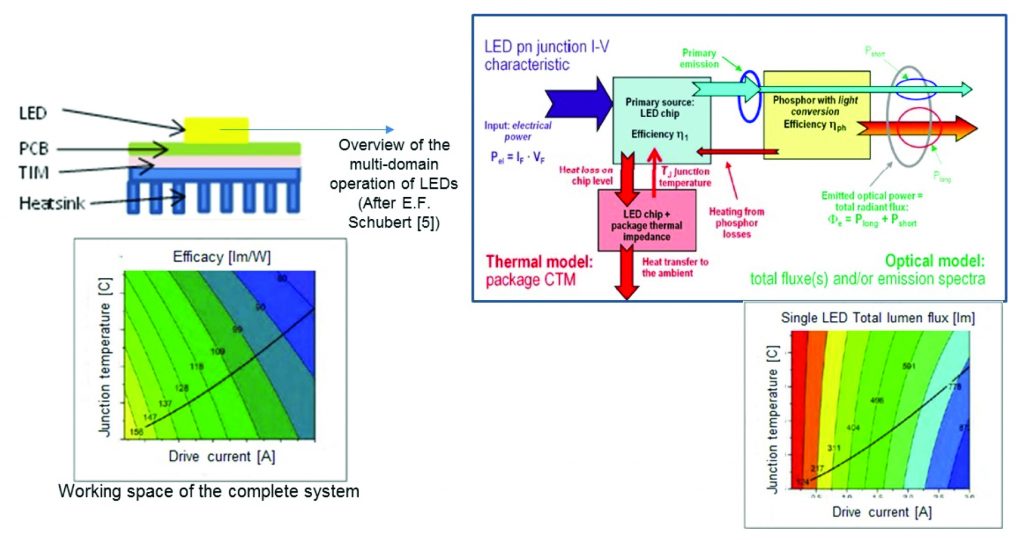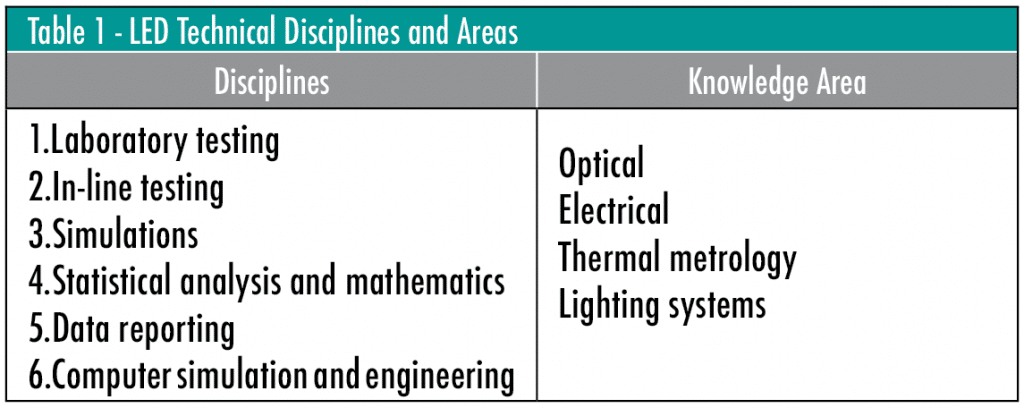Co-authored by: Genevieve Martin*, Andras Poppe, Sangye Lungten, Veli Heikkinen, Joan Yu, Marta Rencz, Robin Bornoff
*Corresponding Author
Introduction
The rise of LED technology is changing the ecosystem of the lighting industry. Delphi4LED [1] is a European Union consortium that is responding to these changes by providing the EU LED Lighting industry with a set of tools and standards to enable the design and production of more reliable, cost effective and market-leading LED-based lighting solutions.
Currently, LED datasheets report a single figure of merit: the thermal resistance, Rth. This figure of merit is generally specified for one ill-defined operating condition and does not adequately address the intertwined relations among optical, thermal, and electrical performance requirements. Effective luminaire design requires more granularity than is currently available in conventional LED datasheets. A comprehensive mathematical description of LEDs that includes thermal, optical, and electrical performance is needed to establish the complete working space of each LED used at luminaire levels. This will allow designers to account for the effects of other LEDs and electronic components.
The DELPHI4LED Mission
The adoption of Light Emitting Diode (LED) shifts the lighting industry’s market and supply chain boundaries from those established by the conventional lighting industry. What was essentially an oligopolistic industry that has been dominated by European companies is rapidly becoming a more competitive environment that includes worldwide players from industries other than LEDs, such as sensors & controls and integrated circuit technologies.
The conventional lighting market, which has traditionally been significantly driven primarily by replacement needs, is substantially being altered by the growing use of LEDs. With the longer life of LEDs, the replacement market is seeing a natural decline as consumers need to replace their light source less often. This is projected to cause the total light source market to flatten out after 2016 [2]. This in turn will accelerate the value shift from light sources towards fixtures as well as lighting system controls. This emerging new arena impacts the distribution channel structure of the market environment. The importance of technical know-how is increasing, particularly in professional distribution channels, due to LED and lighting controls system penetration.
The Delphi4LED consortium provides a holistic response to this market transition by combining the competitive lighting knowledge base in Europe with new paradigms and corresponding solutions o the product creation process. The primary goal is to simplify the early development phase by standardizing Compact LED models for design and simulation. Standardized Compact Models of LEDs, which do not yet exist, will be implemented with models of other electronic and mechanical components to establish a more unified computer-based design and simulation environment for integrated lighting products.
Introducing standard data interfaces, design methodologies and tools will bridge the design gaps between different players and disciplines in the Solid State Lighting (SSL) ecosystem by:
- accelerating the development, and improving the accuracy, of product performance predictions while minimizing the need for building physical prototypes,
- reducing the price point of the resulting solutions,
- increasing options for introducing greater creativity in systems and solutions.
Addressing The Technical Challenges
The main challenge for designing LED components into lighting systems is determining the correct LED inputs. Currently, input is provided in the form of a single figure of merit: the thermal resistance, Rth. This figure of merit is generally specified for one ill-defined operating condition and does not adequately address the intertwined relations among optical, thermal, and electrical performance requirements. This lack of information is due to the ill-defined characterization of LEDs, which is exacerbated by the need for LED suppliers to protect their intellectual property.
Figure 1 illustrates the need to have a comprehensive mathematical description of LEDs that includes thermal, optical, and electrical performance to establish the complete working space of each LED used at luminaire levels. This will allow designers to account for the effects of other LEDs and electronic components.
Moving Towards Greater Standardization
The design of LED systems will be significantly improved with the use of a modular, multi-domain based modelling approach. This modular approach will provide design flexibility for LED component integrators in any kind of luminaire design. Establishing this capability requires seamless integration of the LED into the product development chain.
Standardization creates a communication bridge between the semiconductor industry (LED supplier) and the Lighting industry (LED component integrators) and improves the quality of lighting design implementation. The main objective is to establish a standardized method to create multi-domain LED based design and simulation tools for the industry (Figure 2).

To achieve this, the following tools have to be provided:
- Generic, multi-domain model of LED chips
- Compact thermal model of the LED chips’ environment, including package and substrate
- Interfaces of compact models linking them with the luminaire system design

The goal of the project is to develop a standardized method to create multi-domain LED compact models from test data (Figure 3).
The key objectives are to:
- Define a set of LED model equations that can be implemented into a FEM/CFD tool, for the purpose of self-consistent multi-domain simulation of an LED’s thermal, electrical and light output characteristics.
- Provide interfaces between measurement tools, modeling tools and simulation tools to allow compact LED models to be applied.
- Demonstrate the benefits of using compact models in the development process to reduce development times and cost, as well as to prepare for the digital revolution (e.g. Industry 4.0).
Who is Behind The Project?
A multi-disciplinary approach has been selected by Delphi4LED to foster the adoption of its recommendations by the marketplace. At most SSL companies, thermal, optical and electrical measurements are typically treated in an isolated manner because different testing teams and labs have not been adapted to the changing landscape of the solid-state lighting industry. Although a combined thermal and radiometric/photometric testing method does exist for LEDs, it is still primarily used only in the traditional manner by LED thermal testing teams.
Due to the lack of appropriate standardized multi-domain testing protocols, these methods are not widespread in either the lighting community or among the LED suppliers. Measurement-based characterizations are completed with computer simulations.
The methodology that will be developed by Delphi4LED will be completed by end-user validation at luminaire level. The adopted methodology will not require any sharing of proprietary information from LED manufacturers. Table 1 lists specific technical disciplines, as well as general knowledge areas, that are needed for developing successful LED lighting products.
The Delphi4LED consortium includes 15 partners from 7 countries and brings together luminaire manufacturers, academia, and software vendors. These three areas provide the following capabilities:
- Industry partners who are involved in the direct LED value chain can provide knowledge related to the LED portfolio combined with the end-use applications.
- Academic partners can provide profound knowledge on compact model methodology, measurement techniques and model extraction for LEDs and electronic components in general.
- Software partners who develop the necessary analysis tools will provide knowledge of simulation and integration of multi-domain compact models.
The goal of the consortium is to develop methods that are component-agnostic so that the standardized model is independent from specific LED component designs. Therefore, no LED manufacturers are included in the Delphi4LED consortium to ensure that the standardization methods do not require input from an LED manufacturer.

Expected Impact of DELPHI4LED
The European lighting industry faces two key challenges as a result of the introduction of LED:
- On the market side, it is necessary to reduce development time, improve the quality of current LED products and emphasize value-added activities to gain competitive advantage.
- On the development side, LED lighting has challenges that differ from conventional lighting applications. New characterization procedures, as well as new standardization methods, need to be defined to accelerate the adoption of LED. This will require advances to industry standards in the lighting industry.
This project aims to reduce the time to market of LED products by one-third, cut development costs by 50%, and reduce the indirect costs related to yield by 25%. The goal is to provide the European lighting industry a unique competitive advantage to keep up with the current 30-40% rate of LED market growth and tap into potential new markets.
Summary
The Delphi4LED project, which formally began in June 2016, is intended to provide an answer to rapid market transition. This project will combine the competitive lighting knowledge base in Europe with new paradigms and corresponding solutions in the product design process by developing standardized compact LED models for design and simulation.
Combining these models with models of other electronic and mechanical components will unify the computer- based design environment for integrated lighting products. Bridging the design gaps between different players in the chain will accelerate development, increase the accuracy of predictions for final products, reduce the price of LED solutions, and increase design flexibility by allowing for greater creativity freedom in systems and end-user products.
Acknowledgements
The contribution of European Union is acknowledged for supporting the study in the context of the ECSEL Joint Undertaking programme (2016-2019). Additional information available on: www.delphi4led.eu
The authors wish to thank all the members of the consortium: The teams of Teknologian Tutkimuskeskus VTT Oy, Finland; Technical University Eindhoven, The Netherlands, Flexbright Oy, Finland; Lighting Design Collective Oy, Finland; Magillem Design Services SAS, France; Pi Lighting SARL, Switzerland; PISEO, France; Philips Lighting, France; Philips Lighting, The Netherlands; Ecce’Lectro, France; Feilo Sylvania Lighting Belgium NV; Mentor Graphics, United Kingdom; Philips Lighting, The Netherlands, Technical Uniersity Eindhoven, The Netherlands Ingelux, France; Department of Electron Devices-Budapest University of Technology and Economics, Hungary; Mentor Graphics, Hungary
References
[1]DELPHI4LED, www.delphi4led.org, last accessed November 29, 2016.
[2]McKinsey & Company, “Lighting the Way: Perspectives on Global Lighting Market” Second Edition, August 2012, https://www.mckinsey.de/files/Lighting_the_way_Perspectives_on_global_lighting_market_2012.pdf, last accessed November 29, 2016.
[3]G.Farkas, Qv.v.Vader, A.Poppe, G.Bognar, Thermal investigation of high power optical devices by transient testing, IEEE transactions on Components and Packaging Technologies, pp45-50, Volume 28, issue 1, (2005)
[4]G.Martin, R.Bornoff, V.Hildenbrand, S.Lungten, C.Marty, A.Poppe, M.Rencz, w.h.a.Schilders, , J.H. Yu,, Delphi4LED ‐ From Measurements to Standardized Multi-Domain Compact Models of LED: a new European R&D project for predictive and efficient multi‐domain modeling and simulation of LEDs at all integration levels along the SSL supply chain, Therminic, (2016)
[5]E.F. Schubert, Light-Emitting Diodes, 2nd ed., Cambridge University Press, New York, USA, (2006)







